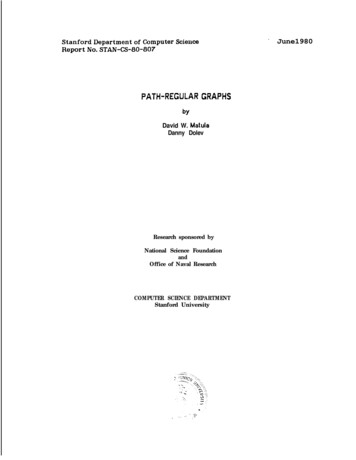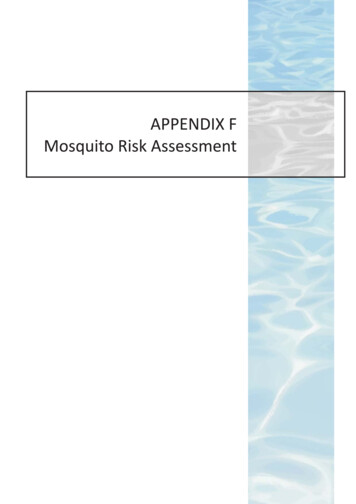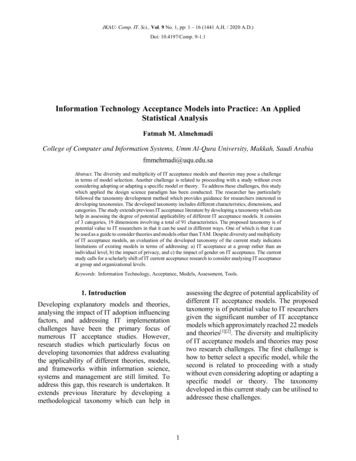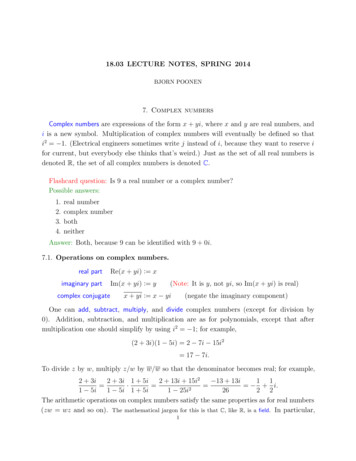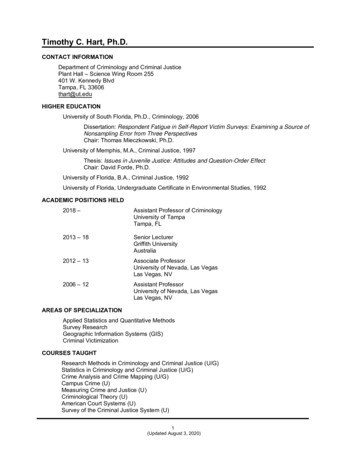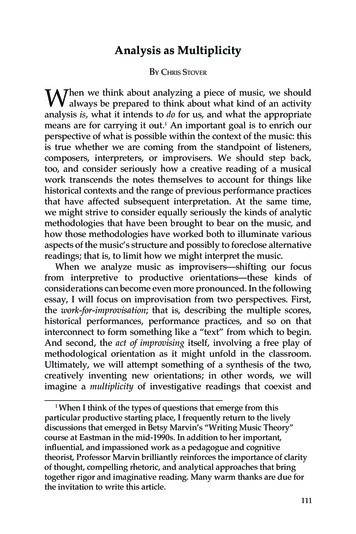
Transcription
Analysis as MultiplicityAnalysis as MultiplicityBy Chris StoverWhen we think about analyzing a piece of music, we shouldalways be prepared to think about what kind of an activityanalysis is, what it intends to do for us, and what the appropriatemeans are for carrying it out.1 An important goal is to enrich ourperspective of what is possible within the context of the music: thisis true whether we are coming from the standpoint of listeners,composers, interpreters, or improvisers. We should step back,too, and consider seriously how a creative reading of a musicalwork transcends the notes themselves to account for things likehistorical contexts and the range of previous performance practicesthat have affected subsequent interpretation. At the same time,we might strive to consider equally seriously the kinds of analyticmethodologies that have been brought to bear on the music, andhow those methodologies have worked both to illuminate variousaspects of the music’s structure and possibly to foreclose alternativereadings; that is, to limit how we might interpret the music.When we analyze music as improvisers—shifting our focusfrom interpretive to productive orientations—these kinds ofconsiderations can become even more pronounced. In the followingessay, I will focus on improvisation from two perspectives. First,the work-for-improvisation; that is, describing the multiple scores,historical performances, performance practices, and so on thatinterconnect to form something like a “text” from which to begin.And second, the act of improvising itself, involving a free play ofmethodological orientation as it might unfold in the classroom.Ultimately, we will attempt something of a synthesis of the two,creatively inventing new orientations; in other words, we willimagine a multiplicity of investigative readings that coexist andWhen I think of the types of questions that emerge from thisparticular productive starting place, I frequently return to the livelydiscussions that emerged in Betsy Marvin’s “Writing Music Theory”course at Eastman in the mid-1990s. In addition to her important,influential, and impassioned work as a pedagogue and cognitivetheorist, Professor Marvin brilliantly reinforces the importance of clarityof thought, compelling rhetoric, and analytical approaches that bringtogether rigor and imaginative reading. Many warm thanks are due forthe invitation to write this article.1111
JOURNAL OF MUSIC THEORY PEDAGOGYenrich one another.2 The endpoint of this investigation is an analyticapproach that is intended to open a range of ways that we mightbegin to creatively define the analyzed object. The goal here is notso much to open an experiential field by bracketing out the knownin search of increasingly novel “solutions” as to point toward asolution in which multiple correct readings question, challenge,and enrich one another. Another way to think of this is that weare going to approach analysis by considering a range of knowns,following our individual experiences of prior analytic forays, but tocontinually acknowledge and then bracket out those knowns in thepursuit of further information and further creative readings.Our thesis, then, begins with a two-part question: for animprovising musician, what is the improvisational object; and howmight one engage that object as and how it presents itself?3 In orderto engage these questions, I will examine Victor Schertzinger andJohnny Mercer’s 1941 song “I Remember You,” which, like manycontemporaneous songs has taken on a rich and varied life as ajazz standard. The following reading of “I Remember You” willconsider multiple texts—the fake book “lead sheet” most knownto jazz musicians, the published piano sheet music, the originalrecording by the Jimmy Dorsey Orchestra featuring Bob Eberly,and seminal jazz recordings by Charlie Parker, Lee Konitz, andDave Brubeck—focusing on how all of these interrelate with oneanother to contribute to our multiplicity. In this way we will be“Multiplicity” is here meant as a construct in which the individualityof each reading contributes dynamically to the plural identity of thework that we’re interpreting. While it is not crucial to an understandingof the following study to know this, much of my line of thought isindebted to the philosophical orientation of Gilles Deleuze, and inparticular the way that Deleuze playfully, but powerfully, replacesidentity (“is”) with multiplicity (“and and and ”) as one of thefundamental aspects of a philosophy that foregrounds qualitativedifference as prior to, and frankly more interesting than, sameness. Theinterested reader might refer to Deleuze, Bergsonism and Difference andRepetition as valuable entry-points into Deleuze’s way of thinking.2Throughout this essay I will use “object” in a particular sense: as athing that is itself in a constant state of change. This refers both to whatwe might call its existential qualities, as a living thing whose identity isbest described in terms of flux (this is Deleuze’s difference-as-identity),and from the perspective of the observer: the change that results frombringing new phenomenological or methodological perspectives to bearon the object.3112
Analysis as Multiplicityable to open up a rather large horizon of methodological vantagepoints without necessarily concerning ourselves with the way thatmethodological identity limits behavioral possibilities of the musicunder examination. For example, in order to engage chord/scaletheory and its one-to-one correspondences between seven-notechords and the scales that map onto them, we should accept itsinsistence on “avoid notes” and the ways that it flattens harmonicfunction and voice-leading behaviors.4 But we might also recastsuch insistence as strategic and situational in order to consider aradical reading of chord/scale theory that does take such behaviorsinto account.5 Likewise, we will point toward a methodologicalmodel that will draw upon Schenkerian theory, but that subtlyextends aspects of that theory to reflect a musical syntax that differsin significant ways from those of earlier tonal processes. Eventuallya reading of consonance and dissonance will emerge from someof the details of how the music communicates its essence to us;this will be described in terms of a contingent and “tune-specific”notion of consonance and dissonance.So let us begin our investigation, with the intention of discoveringthe identity-as-multiplicity of a piece of music. “I RememberYou” has become a canonical jazz standard, with hundreds ofdocumented recordings and a staple at jam sessions. One versionThe concept of “avoid notes” emerged in jazz pedagogy assomething of a workaround for advocates of chord/scale theory. Inshort, it recasts expressive dissonant notes like the fourth degree of themajor (Ionian) scale as a note to be avoided when improvising usingthat chord/scale (that is, Major Seventh / Ionian). For a nice descriptionof the discursive complication, to say nothing of the highly troublingsyntactic implications of this frame of thinking, see Treseler, The LivingJazz Tradition.4Some key pedagogical texts on chord/scale theory includeAebersold, How to Play Jazz and Improvise and The II-V7-I Progression,Baker, How to Play Bebop, vol. 1-3, Haerle, The Jazz Language: A Theory Textfor Jazz Composition and Improvisation, and Levine, The Jazz Theory Book.Much of this work draws upon and extends John Mehegan’s first foraysinto chord/scale mappings (Mehegan, Jazz Improvisation Vol. 1: Tonal andRhythmic Principles), the significance of which Henry Martin describesin his summary of the state of jazz theory (Martin, “Jazz Theory: AnOverview”). For critiques of some of the foundational principles ofchord/scale theory see Rawlins, “Review of Mark Levine, The Jazz TheoryBook” and Stover, “Theory, Pedagogy, and the Ethics of Chord/ScaleIsomorphism: Toward a Minor Literature of Modern Jazz Practice.”5113
JOURNAL OF MUSIC THEORY PEDAGOGYthat is particularly well-known in the jazz community is CharlieParker’s 1954 quartet recording for Clef Records, with Al Haig onpiano, Percy Heath on bass, and Max Roach on drums, an excerpt ofwhich can be heard at www.morezero.com/parker head.mp3. Wemight constructively compare Parker’s version with the original1941 recording by Bob Eberly and the Jimmy Dorsey Orchestra,which can be heard at www.morezero.com/dorsey.mp3, to beginto get a sense of the song’s interpretive range.6After listening to these versions, and a few others, I wouldencourage my students to begin by drawing upon their analytic (orsimply observational) experience. This turns out to be a rather morecomplex question than first assumed. After all, the Broadway showtunes and motion picture hits from the first half of the twentiethcentury, many of which comprise the large repertoire knowncollectively as the Great American Songbook, were not written tobe improvised on, at least in the sense that jazz musicians generallyintend, as vehicles for extended extemporization. But of course oversubsequent decades there has been a vast and richly differentiatedlegacy of jazz musicians doing exactly that, using these songs aslaunching points for all kinds of idiomatic, even idiosyncratic,exploration, drawing upon not only the melodic, harmonic,rhythmic, and formal elements of the tune itself but on layers ofoverlapping and occasionally contradictory ways of conceiving ofthe improvisational object that define some of those very idiomsand allow for some of those idiosyncracies. Bruce Ellis Bensonsuccinctly describes this plural way of thinking: “the ‘structures’that we call pieces of music are ‘composed’ of the activity of musicmaking itself, rather than music making ‘plus some other thing’(that we would call a ‘work’)”; in other words, the original activityof composing that results in the score interpenetrates with layersof interpretive activity, all of which conspire to form the musical“structure.”7Dorsey’s recording dates from December 1941, just a few weeksbefore the January 1942 release of the motion picture The Fleet’s In, forwhich it was written. The seamless way that Eberly links the verse ofthe tune—not discussed in this brief exposition due to space constraintsand the fact that with a few notable exceptions jazz musicians tend toset aside the verses of the tunes they play—with the refrain is among themany lovely aspects of this recording.6Benson, The Improvisation of Musical Dialogue, 161. The overlappingand occasionally contradictory engagement refers in part to the7114
Analysis as MultiplicitySo an entry into the improvisatory potential of a tune like “IRemember You” should address a wide range of analytic andexperiential vantage points, and should be prepared to bring theminto dialogue in some way, whatever that may end up meaning.Again, just to have some kind of a common starting point, I wouldask a group of students to begin by bringing the knowledge of theirimmediately reachable analytic experience to bear, and to withholdjudgment about what is correct or better or real “until all the evidence(or at least sufficient evidence) is in.”8 With every group of studentsthat I have taken through this project, the same quite interestingresult occurred, which was that students began first to addressissues of harmonic function in one of two ways (and the second ofthe two followed closely): either to focus on scalar collections thatmight be applied unproblematically to the harmonic progressionof the tune, or to identify surface-level local tonal areas in terms of“II-Vs” and similar chunks of tonal information. In other words, wemight first proceed into something like that shown in either Figure1, which foregrounds clear and relatively unmarked chord/scalerelations, or Figure 2, which begins to chunk surface-level tonalprogressions, and the second approach would follow close behind.Or perhaps something like Figure 3, which begins to engage somestrategic decisions about what scale might comparably representboth a local tonal area being traversed and its relation to the globalkey (marking the chord/scale relations, in other words). Theannotation in Figure 3 reflects how careful prescriptive attention isgiven to behaviors that stem from the chords and local tonal areas,as well as how those chords and local tonal spaces compose outthe global key (which in turn will eventually point to some of thelarger-scale voice-leading considerations discussed below).application of (modal-based) chord/scale theory to tonal processes,which is addressed briefly below and in more detail in Stover, “Theory,Pedagogy, and the Ethics of Chord/Scale Isomorphism.”8Ihde, Experimental Phenomenology, 36.115
JOURNAL OF MUSIC THEORY PEDAGOGYFigure 1. “Literal” Chord/Scale Reading.116
Analysis as MultiplicityFigure 2. Tonal Harmonic Analysis.117
JOURNAL OF MUSIC THEORY PEDAGOGYFigure 3. “Tonal” Chord/Scale Reading.118
Analysis as MultiplicityWe might think of the first chord/scale stratum from Figure 3as a fairly straightforward, mundane reading (following that fromFigure 1), and the second stratum as one that engages tonal areasa bit more thoughtfully, making strategic decisions based on thelocal functional relation of sonic events to one another. While thesecond stratum builds upon the first, we might take extra care hereto resist thinking of it as a refinement or improvement—this in theinterest of imagining as wide a range of “correct” answers as wecan—and we should continue to think of all of these readings interms of what value they might potentially bring to our emergingunderstanding. In other words, and as we will see playing out inpractice below, both strata (and more) co-exist and can serve aspotential paths through the harmonic framework of the tune.Following this array of “correct” answers, we can investigate aplural solution that allows for multiple paths through the tune’sharmonic framework, with multiple scale options that might beapplied to particular chords or pairs of chords (especially II-Vs),based on context, and that also addresses some fundamental voiceleading considerations that arise from harmonic function. Figure 4shows one such path through the form, synthesizing our first andstrategically chosen strata from our third examples. Note how thechord/scale interpretation culls variously from the two strata inFigure 3; there were specific musically-inspired reasons for thesedecisions, some of which we will return to below. The importantthing to reinforce is that as we examine each reading, we thenbracket it out to the best of our ability, as a viable reading to whichwe’ll return.At this point in the process it might be useful to offer anadmonition from Ornette Coleman about focusing overly on theharmonic progression of a tune: “let’s play the music and not itsbackground!”9 Coleman was concerned about the seeminglyexclusive emphasis by contemporaneous improvisers on a tune’sharmonic framework, and thus by the dismissal of a tune’sarguably most salient feature, its melody. While Henry Martin hasconvincingly argued that at the highest levels this is not entirelytrue, Coleman’s point is well taken.10 And as the student responses9First cited by Martin Williams in the liner notes to Coleman, Free Jazz.See Martin, Charlie Parker and Thematic Improvisation and “CharlieParker and ‘Honeysuckle Rose’: Voice Leading, Formula, and Motive”for compelling readings of Parker’s improvisations that focus on melodicdevelopment and its relation to deep structure. See also Hermann,10119
JOURNAL OF MUSIC THEORY PEDAGOGYFigure 4. One Pass at Synthesizing Tonal Analysis and Chord/Scale Reading.120
Analysis as Multiplicitydescribed above suggest, the melody is certainly not the first aspectof a tune that aspiring jazz musicians tend to focus on, nor is it acornerstone of modern pedagogical practice.11So I might ask a class at this juncture, what about the melody?What do you find about the melody of “I Remember You” thatis compelling to you as an improviser? And again, what does“compelling” mean from a productive standpoint, and whatmight you do with those compelling features? An annotated leadsheet, based on the version well known to jazz musicians fromThe Real Book, is shown in Figure 5. Thinking in terms of whatjazz musicians say they privilege we might ask what the mostdistinctive components are that telegraph the identity of the tuneto the listener, and about the lyrics, which virtually every jazzmusician claims as a fundamental beginning point. We might noticethe opening gesture, a weak-beat upper neighbor ornamenting aconsonant third, and the subsequent role that upper neighbors playas the tune unfolds. We might notice the middleground chromaticdescent of the “A” section (described below). We might notice theway that repetition abets motivic development: the opening motif(marked “M1” in Figure 5) repeats, but is chromatically inflectedin order to propel the second iteration all the way to the end ofmeasure eight. Then we might consider how when the openingmotif returns in the bridge it itself is prolonged for four measuresto effect the modulation to VI. Indeed, just about all of the motivicactivity in “I Remember You” can easily be shown to emerge fromthat opening gesture. The way that motivic continuity is employedto aid the transition between third-related harmonic spaces willplay out in compelling ways in the middleground analysis below.Following another stream of modern jazz improvisationalpractice, we might consider some of the characteristic motivicfeatures of “I Remember You” in terms of their potential fordevelopment: how might we transpose, invert, retrograde,“Charlie Parker’s Solo to ‘Ornithology’: Facets of Counterpoint, Analysis,and Pedagogy,” Larson, “The Art of Charlie Parker’s Rhetoric,” Love,“‘Possible Paths’: Schemata of Phrasing and Melody in Charlie Parker’sBlues,” and Strunk, “Bebop Melodic Lines: Tonal Characteristics” forfurther evidence from different analytic perspectives.I provide evidence for the nearly-exclusive focus on chords andchord/scale mappings in several of the most popular jazz theory andimprovisational method books in Stover, “Theory, Pedagogy, and theEthics of Chord/Scale Isomorphism.”11121
JOURNAL OF MUSIC THEORY PEDAGOGYFigure 5. Some Distinctive Motivic Features.122
Analysis as Multiplicitytruncate, expand, elide, concatenate, or otherwise manipulate amotif? How might those transformations then be employed in animprovisation that itself attends carefully to the tune’s harmonicprogression? Or might we imagine one that recasts the tune in anyof an infinite range of imaginative ways, including the invention ofnew developmental processes?12Likewise, the lyrics for “I Remember You” suggest compellinginterpretive possibilities, from standpoints of motivic developmentand phrase structure. The sentiments of the song’s lyrics arecharming and nostalgic in the manner of many World War II-erapopular songs, and there is value in mentioning that lyricist JohnnyMercer acknowledges its mildly scandalous origins, describinghow he wrote it specifically “for Judy Garland. I always had sucha crush on Garland that I couldn’t think straight, so I wrote thissong.”13 Perhaps more clearly germane for the present account,though, is the way in which the prosody of the lyrics shapes theextensions and compressions of motivic material, which turns outto be crucial for the particular path through which the song’s phrasestructure unfolds. Figure 6 illustrates how prosody and rhymegenerate intricate phrase relations from expansions of the initialmotif. Here the opening line “I remember you” is followed by theparallel, rhyming phrase “you’re the one who made my dreamscome true,” adding four syllables to the initial statement. Themelodic line of the second phrase begins parallel to the first, takingthe melody down from E to Eb, and the extra four syllables enactthe “pseudo-sequential” action described in Figure 5 above. Thereare thus at least two antecedent–consequent relations to attendto: the parallelism of the two five-note motifs ending on 7 and b7respectively, and the extension of the second phrase that followsthe lyrics’ rhyme scheme. We might also notice that the “ago” thatends the first eight-measure unit finds its rhymed counterpart eightmeasures later, reinforcing the structural significance of 5, whichwill be described shortly. But à propos of the initial motif, we see thetemporally displaced rhyme of measure five pushed an additionalWhile several published method books describe melodic manipulationand development (see Liebman, A Chromatic Approach to Jazz Harmony andMelody, 45–52, for one compelling exposition), sources that consider howto develop melodic and motivic ideas derived from the tune being played arefrustratingly rare. We will see one particularly clear example of motivicmanipulation when we investigate Brubeck’s improvised solo below.1213Cited in Furia, Skylark: The Life and Times of Johnny Mercer, 131.123
JOURNAL OF MUSIC THEORY PEDAGOGYFigure 6. Role of Prosody and Rhyme in Development of Phrase Structure.124
Analysis as Multiplicitytwo measures back in the bridge; this second displacement isitself enacted by the addition of a new internal rhyme on “bell”and “fell.” Finally, in the last A section the consequent rhyme isdisplaced further, to the eleventh measure, this time abetted by theinternal rhyme of “recall” and “all.” It is no stretch to suggest thatthe way Mercer elongates his phrases through displaced rhymesnecessitates the unusual 36-measure structure of the song.Up to this point we have considered issues of harmonic identity,chord/scale relations, motivic identity, and the fluid phrasestructure suggested by the prosody of the lyrics. I would nextask students to consider some elements of deeper structure andprocess, which generally involves more hand-holding than some ofthe directions we’ve explored thus far, but which rewards the timespent, especially as we begin to synthesize all of these differentvantage points into the multiplicity alluded to above, in which allblend into and inform one another.“I Remember You”’s opening melodic gesture rises from 7 to 1over tonic harmony. That semitone motion is mirrored in the firstharmonic action—FMaj7 moving down to E7 as the continuation ofthe II-V motion of measure two; note that in the sheet music version(and in the Jimmy Dorsey recording) there is no pre-dominantchord in this measure—we should take this under consideration aswe occasionally elide II-Vs into single harmonic objects.14 We canthink of this opening melodic gesture from at least two structuralperspectives: 7 as a lower neighbor to a structurally prior 1 onbeat two, or 1 as an incomplete upper neighbor to 7. As Figure 7illustrates, the first reading opens up an interesting long-rangeprocess through the first eight measure of the tune; 1 enacting adescending chromatic line to 5 in measure seven.In the 1941 sheet music (which is in the key of G), the secondmeasure is an F# chord, but with G in the bass as a pedal point linkingmeasures one and three—we’ll see below that this reinforces somebasic claims that are being made here about structural parallelisms andcomposings-out of melodic gestures.14125
JOURNAL OF MUSIC THEORY PEDAGOGYFigure 7. Two Interpretations of Voice Leading in the First Eight-Bar Phrase.Figure 7B, conversely, reveals a compelling chromatic descent to5 that begins on 7, with its incomplete upper neighbor and filledin lower third (a more detailed reading might question whetherthis third actually suggests an inner voice or compound melody—we’ll return to this consideration in the analysis of Lee Konitz’ssolo below), repeats on b7 (reiterating the upper neighbor gesture)as it passes to 6 supporting pre-dominant harmony, then to b6with one more upper neighbor to take us to 5. As described in theaccount of motivic structure in Figure 7, a great deal of melodicaction is generated from the melodic figuration of the first measure,and especially from the structural status of the opening dyad.An interesting conundrum results from this reading, however. Ifstructural and surface melodic action are generated from 7 and itsdependent upper neighbor, then it seems we are making a case for7 over tonic harmony to be a consonant structural note, and 1 (tonic,as well as the root of the chord) to be an expressive dissonance.This reinforces a point about the particular kinds of tonal behaviorsthat occur in the music of the Great American Songbook and jazzstandards, which is that, unlike a great deal of the tonal music thatpreceded and informed it, chordal sevenths are pervasive andvery often structurally consonant, even on tonic chords.15 This is aSchenker recognized numerous situations in which the seventh ofa V7 chord would be prolonged by an upper-neighbor root. An alternate15126
Analysis as Multiplicitypoint that cannot be reinforced enough; indeed, I would argue thatmany theorists who have been using Schenkerian methodologiesto describe jazz practice are doing some small amount of harmto the music by insisting on reducing sevenths to diminutions ofmore fundamental triadic structures, rather than allowing themto behave as structurally consonant and process-generating chordtones, such as that shown in the opening of “I Remember You.”16Considering 7 as a generator of middleground structure alsosupports the reading of the bridge to “I Remember You” shownin Figure 8, in which 3 supports a IVMaj7 chord (again with itsdependent incomplete upper neighbor), which descends through2 to #1 supporting VIMaj7 in a lovely unfolding of pre-dominantharmony (IV transformed into VI through 5-6 technique), then to1 through mode mixture and ultimately to 7 and the dominantinterruption.Figure 8. Voice Leading in the Bridge, Following Figure 7B.There are a few more features of harmonic relationships in“I Remember You” that Figure 8 makes clear. First, recall againhow the opening melodic gesture is repeated in the key of thereading of the present narrative therefore might be one that extrapolatessuch behavior over tonic harmony, following a free contrapuntalframework that begins with seventh chords as syntactically consonant,whether in tonic, pre-dominant, or dominant contexts.Mark McFarland offers an excellent synopsis of a schism in the jazzscholarly community, between those that insist on a more conventionalSchenkerian approach and those that lean toward recasting Schenkerianprinciples in terms of a hybrid syntax in which sevenths are consonantand that allows for a (slightly) larger number of fundamental lines toserve as background structures. See McFarland, “Schenker and the TonalJazz Repertory: A Response to Martin.”16127
JOURNAL OF MUSIC THEORY PEDAGOGYsubdominant. Here the harmonic motion projected from thebass—which originally played out as a lower neighbor returningto tonic, 1 to 7, with the latter’s dependent upper fifth, and backto 1—is recast as V in the key of the major submediant. As Figure9 suggests, the resolution-drive of measure two is denied, only tobe realized in measure eighteen; in other words, the II-V in A ofmeasure two moves deceptively to its bVI, while the analogousaction in measure eighteen completes the harmonic motion tothe local tonic. Note that the choice here to read the motion frommeasure two to three as deceptive within the local context ofthe II-V in A is intended to be construed alongside our earlierreading, in which measure two prolongs a bass lower neighbor.Also note how this additional interpretation influences the chord/scale decision shown in Figure 4; if we think of measure two asan unresolved (or deceptively resolved) II-V that will eventuallybe substantiated in the bridge, then a chord/scale reading thatemphasizes its local major-key II-V-ness will reinforce thatinterpretation.Figure 9. Non-Fulfillment and Fulfillment of Resolution Impulse.Such a pluralist reading of elaboration and functional implicationbecomes a much more important consideration when we zoom outto examine still larger-scale voice-leading connections. The readingshown in Figure 10 suggests that the dramatic octave displacementof the final “A” section, which transfers 5 to the higher octave, inorder to enact a quick but greatly delayed five-line descent, is theresult of a reaching-over in which the middle voice 5 is revealed asan important—the most important—structural generator. What thisdoes to our earlier reading of 7 is it recharacterizes it as an upperthird elaboration of 5; in other words, we’re now reconsidering 7 as128
Analysis as Multiplicitycloser to a surface-level phenomenon. What I would like to reinforcehere, however, just like the dual reading of measure two in Figure9 suggests, is that these two readings operate at roughly equivalentstrata; that the nearer-to-surface level is not subordinate to the longerrange level. This is what Deleuze would call a rhizomatic readingrather than a more traditional tree structure, and it suggests that wecan choose to focus on one reading or the other, depending on ourproductive needs as improvisers. It is also one of the many reasonsthat I been driving toward conceptual language like multiplicitiesand pluralities: not just the way that this particular analytic projectis being cast fundamentally as a multiplicity, but encouraging thereader to think about existing analytic methodologies in terms oftheir potential contribution toward reading-as-multiplicity, ortoward their potential creative disruption. To this end, we couldimagine the further interpretation shown in Figure 11, in which thehigher-octave 5 is transferred from the upper-voice 5 that ends thefirst “A” section (measure seven), which itself is approached via itsupper third (and which in turn therefore enacts the series of upperthirds that appear throughout).Figure 10. A Deeper Middleground Reading of the Entire Tune.Figure 11. An Additional Interpretive Layer: Displacement of Up
Jazz tradition. 5 Some key pedagogical texts on chord/scale theory include Aebersold, How to play Jazz and improvise and the ii-V7-i progression, Baker, How to play Bebop, vol. 1-3, Haerle, the Jazz language: A theory text for Jazz composition and improvisation, and Levine, the Jazz theory Book.
